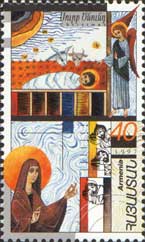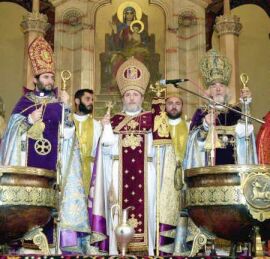|
Armenia is in southwestern Asia, east of Turkey. Other neighbors are
Georgia and Azerbaijan.
 Armenians believe Christ's
birthday should be celebrated on the same day as His baptism, which is
January 6 by our calendar (Gregorian). By the old Julian calendar this
date would fall on our January 19. The old Julian calendar is still
used by Armenians in the Holy Land to set the date of their Christmas
while in Armenia, they celebrate on January 6 (Epiphany) by the Western
calendar. At the same time, this date is Christmas Eve on the old
Julian calendar and that is when Russia, Syria, Iraq, Ethiopia and
other countries east of Rome celebrate the traditional Orthodox
Christian Christmas. Confusing? How about the fact that Armenians
who live in the United States often celebrate when we do on December 25,
using the same calendar that is used by the Western world. After that
they have a second celebration on January 6 that is more attuned to
the traditional Armenian holiday and turns away from the commercialized
celebration held two weeks earlier. Armenians believe Christ's
birthday should be celebrated on the same day as His baptism, which is
January 6 by our calendar (Gregorian). By the old Julian calendar this
date would fall on our January 19. The old Julian calendar is still
used by Armenians in the Holy Land to set the date of their Christmas
while in Armenia, they celebrate on January 6 (Epiphany) by the Western
calendar. At the same time, this date is Christmas Eve on the old
Julian calendar and that is when Russia, Syria, Iraq, Ethiopia and
other countries east of Rome celebrate the traditional Orthodox
Christian Christmas. Confusing? How about the fact that Armenians
who live in the United States often celebrate when we do on December 25,
using the same calendar that is used by the Western world. After that
they have a second celebration on January 6 that is more attuned to
the traditional Armenian holiday and turns away from the commercialized
celebration held two weeks earlier.
 Historically, all
Christian churches celebrated Christ's birth on January 6th until the
fourth century. At that time, the Roman church hierarchy designated
December 25th as the official date of Christmas and January 6th as
the feast of Epiphany. The Christmas date was selected to undermine
and subdue pagan observances dedicated to the birth of the Sun.
Armenia was not effected by this change for the simple fact that
there were no such
pagan practices in Armenia on that date. Furthermore, the Armenian
Church was not a satellite of the Roman Catholic Church. Thus,
remaining faithful to the traditions of their forefathers, Armenians
continue to celebrate Christmas on January 6. Historically, all
Christian churches celebrated Christ's birth on January 6th until the
fourth century. At that time, the Roman church hierarchy designated
December 25th as the official date of Christmas and January 6th as
the feast of Epiphany. The Christmas date was selected to undermine
and subdue pagan observances dedicated to the birth of the Sun.
Armenia was not effected by this change for the simple fact that
there were no such
pagan practices in Armenia on that date. Furthermore, the Armenian
Church was not a satellite of the Roman Catholic Church. Thus,
remaining faithful to the traditions of their forefathers, Armenians
continue to celebrate Christmas on January 6.
In the Holy Land the Orthodox churches use the old calendar (which
has a difference of twelve days) to determine the date of the religious
feasts. Accordingly, the Armenians in the Holy Land celebrate
Christmas Day on January 19th (our calendar) and the Greek Orthodox
people celebrate on January 7th (our calendar).
The Armenians who go by the old traditions, prepare for Christmas
with a fast. They eat no meat for a week and no food at all on the
last day before Christmas. The fast is broken only after the Christmas
Eve service - Badarak, when they return home to a
dinner of lamb and rice or Boulgeur Pilav.
Hand cymbals and the human voice are the only music at the
Coptic Orthodox Christmas service. As in days of old, women and
men sit in separate sections. Incense clouds waft across shafts
of sunlight that set gold-plated icons aglow on vaulted apses
in the church.
 Following
the service, the children then go onto the roofs of their homes
with handkerchiefs and sing carols. Adults fill the handkerchiefs
with presents of raisins or fried wheat and money. Following
the service, the children then go onto the roofs of their homes
with handkerchiefs and sing carols. Adults fill the handkerchiefs
with presents of raisins or fried wheat and money.
Following the morning service on Christmas Day, the men in the
village exchange social calls and are served coffee and sweets.
On the third day after Christmas, the women take their turn
making and receiving social visits.
In the cities, Christmas decorations can be seen along the
streets, on storefronts, and on outdoor Christmas trees. The
decorations usually stay up until mid-January.
Music: O Come All Ye Faithful
© 2002-05 by W. C. Egan
|